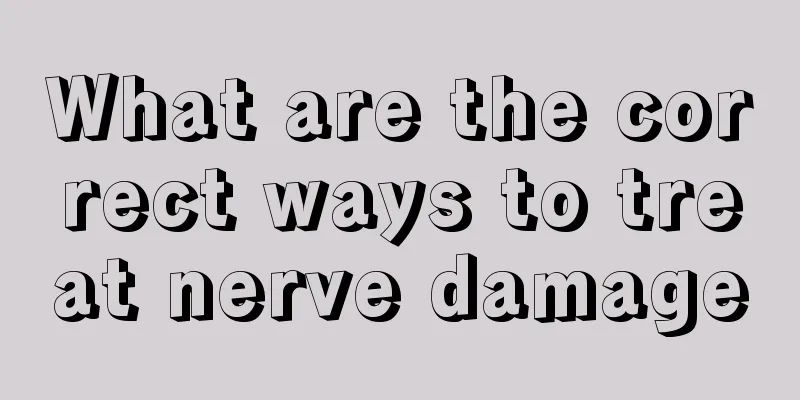What are the correct ways to treat nerve damage

|
The human body is filled with densely packed nerves. Nerve damage can occur due to falls, collisions, malnutrition, and inflammation. Patients with nerve damage can usually be treated temporarily in the early stages with non-surgical methods. Non-surgical treatments use medications of different types. You can go to the hospital for a detailed examination based on the patient's physical condition, and choose between medication or surgical treatment based on the results of the examination. Nonsurgical treatment (1) Dehydration drugs relieve intracranial pressure and neural edema. 150~200ml of 20% mannitol is commonly used for intravenous drip, 1~2 times a day. (2) Glucocorticoid treatment protects the nerves. Dexamethasone 10 mg is usually given intravenously 1 to 2 times a day. (3) Drugs that dilate blood vessels and improve microcirculation include 10 mg of Nimotop, administered intravenously 1 to 2 times a day. Low molecular weight dextran 500ml intravenous drip, 1 to 2 times a day. (4) Common neurotrophic and metabolic drugs include energy mixture, cerebrolysin, GM1, nerve growth factor and metronidazole. Nerve damage Insurable. Methiconazole was administered by intravenous drip at a rate of 500 μg, 1 to 2 times a day. After 10 days, it was changed to oral administration at a rate of 0.5 mg, 3 times a day. Surgery (1) Indications for surgery: ① The fracture fragments compress the cranial nerves. ②Intracranial pressure continues to increase and cranial nerves are compressed. ③ Nonsurgical treatment is ineffective. ④ It causes severe nerve irritation symptoms such as vertigo and neuralgia in the later stage. (2 ) Preoperative preparation: Determine the site of nerve damage through imaging, electrophysiology and clinical manifestations; select the nerves and muscles for transplantation. (3) Surgical method ① Nerve decompression, through intracranial or extracranial approach, using a grinding drill to remove the bone fragments compressing the nerve, clear the hematoma around the nerve, and cut the epineurium under a microscope, such as optic canal and facial nerve canal decompression; ② Nerve reconstruction surgery includes: direct reconstruction, such as direct anastomosis of nerve ends and nerve transplantation anastomosis; indirect reconstruction, such as facial nerve-accessory nerve anastomosis; plastic surgery, such as mouth angle suspension or temporalis muscle and masseter muscle transfer for patients with facial paralysis; cranial nerve destruction surgery, such as selective resection of the trigeminal nerve sensory root to treat trigeminal neuralgia. (4) Postoperative treatment: Comprehensive recovery with medication, physical therapy, and acupuncture Cauda equina injury Cauda equina syndrome is a difficult problem in the world. Clinically, violent spinal fractures, lumbar degenerative lesions, cholesteatoma in the cauda equina, neurilemmoma, spinal meningioma, lipoma or metastatic tumors that stimulate and damage the cauda equina nerve. Currently, Western medical treatment mainly focuses on surgical removal of vertebral bone fragments that are compressed and fractured in the spinal canal, herniated intervertebral discs, and tumors that stimulate the cauda equina, supplemented by dehydrating agents, corticosteroids, nutrients or free radical scavengers. The therapeutic effect is not very ideal and has certain limitations. Director Huo of Henan Traditional Chinese Medicine Expert Clinic has applied traditional Chinese medicine theory and, after nearly 20 years of clinical exploration, has adopted the traditional Chinese medicine "removing blood stasis and unblocking meridians, tonifying the spleen and kidneys, and regulating the water channels" therapy and the traditional Chinese medicine "tumor elimination" method, combined with the traditional Chinese medicine "fascia shock" to treat cauda equina injuries, defecation and sexual dysfunction, and achieved better results, further improving the clinical cure rate of cauda equina syndrome. |
<<: Strong smelling urine? It may be caused by these reasons
>>: What are the characteristics of recurrent herpes
Recommend
What are the effective ways to protect the kidneys
The human kidneys are responsible for metabolism ...
How to choose the correct treatment for thyroid cancer
How to choose the right treatment for thyroid can...
Ways to prevent colon cancer
Have you heard of colon cancer? Colon cancer is a...
Can folliculitis be treated with edible salt water?
Among the many diseases in people's lives, th...
What is the difference between embryo and blastocyst transplantation
In in vitro fertilization, the two most common tr...
Acne on face due to seafood allergy
Many people love to eat seafood, but eating seafo...
How much does it cost to treat ovarian tumors
The ovaries are important reproductive organs for...
What are the side effects of eating donkey-hide gelatin?
1. Getting angry Some people will experience symp...
Symptoms of facial peripheral neuritis
Facial peripheral neuritis is a common disease wi...
What is the survival rate after treatment of stage 3 nasopharyngeal carcinoma
What is the survival rate after treatment for sta...
Symptoms of colon perforation
Colon perforation often occurs in many elderly pe...
How to remove glass scale
Many people hate scale on the glass. This is beca...
Can pregnant women eat apricots? The nutritional value is so rich
Apricots are extremely rich in nutritional value,...
What are the effects of soaking wolfberry and lemon in water
Since the lemon cup came out last year, more and ...
How much does it cost to do radiotherapy only for mid-stage laryngeal cancer
How much does it cost to only do radiotherapy for...









